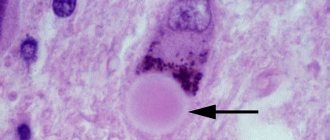Parkinson's disease is characterized by slowly progressive neurological and cognitive impairment. The problem of diagnosing the disease lies in the careless attitude of relatives and doctors to the first symptoms. Typical signs of damage to the nervous system are regarded as a manifestation of natural aging of the body. The disease can be suspected in the early stages using tests and questionnaires to assess the neurological and psychological status. Many of them are simple and do not require much effort or time, so close relatives can independently test for Parkinson's disease at home.
Memory tests
The simplest method for identifying memory impairment is the “5 words” test. The patient is given a sheet of paper on which 5 simple words from everyday vocabulary are written. After reading, the test taker must reproduce them. Then the patient is distracted by a conversation for 3-4 minutes and again asked to repeat the previously read words. If it is impossible to reproduce them immediately after reading, they speak of severe memory impairment, in other cases - of mild or moderate degree.
Another way to assess memory and memorization ability is a questionnaire test. The method is less informative because the testing does not exclude a subjective factor (a person may provide unreliable information). This test is suitable not only for the patient with Parkinson's disease, but also for his close relatives. Memory impairment is indicated when the answer is positive two or more times. The Parkinson's test consists of the following questions:
- Over the last month, have you forgotten to turn off the gas, iron or water?
- Have you lost things in the last month? If yes, how many times?
- Have you ever thought that a close relative looks completely different and you don’t recognize him?
- Do you have difficulty remembering a phone number or a date?
- Do you feel confused in a previously familiar area or area?
Another simple method for identifying the disease and concomitant mental disorders is the date recall test. The patient is asked to say when he or his immediate family was born. Long thinking, inability to answer a question, or ridiculous answers (for example, 03/45/1173) are an unfavorable sign.
Parkinson's disease
19034 May 18
IMPORTANT!
The information in this section cannot be used for self-diagnosis and self-treatment.
In case of pain or other exacerbation of the disease, diagnostic tests should be prescribed only by the attending physician. To make a diagnosis and properly prescribe treatment, you should contact your doctor. Parkinson's disease: causes, symptoms, diagnosis and treatment methods.
Definition
Parkinson's disease is a chronic progressive disease of the brain in which the pathological protein α-synuclein accumulates in the nerve cells of certain areas of the brain and special intracellular inclusions are formed - Lewy bodies, which causes the death of the affected nerve cells. The main function of these neurons is the production of dopamine, which is involved in the control of motor activity, muscle tone, and thought processes. It is assumed that the formation of Lewy bodies begins to occur 15-20 years before the first symptoms of the disease appear in the patient. Thus, clinical manifestations occur when a large number of neurons have already been destroyed.
The disease makes itself felt, as a rule, after 60 years, and men are affected more often than women.
Causes of Parkinson's disease
To date, there is no consensus regarding the causes of Parkinson's disease in humans. Perhaps genetic factors (certain gene mutations) are important.
In addition to true Parkinson's disease (primary parkinsonism), there is so-called secondary parkinsonism. They do not differ in clinical manifestations, but the causes of the latter are known - traumatic brain injury, cerebral stroke (cerebrovascular accident), brain tumors, various intoxications, etc.
Classification of the disease
Parkinson's disease is classified according to its clinical form, stage, and rate of disease progression.
Depending on the predominance of one or another symptom in the clinical picture
There are three clinical forms:
- akinetic-rigid-tremor, or mixed (60-70%);
- akinetic-rigid (15-20%), when muscle stiffness and slowness, poverty of movements predominate;
- trembling (5-10%) with a predominance of trembling of the limbs and head (tremor).
Depending on the stage (severity)
of the disease, there are:
Stage 0 - there are no motor manifestations of the disease; Stage 1 - unilateral manifestations of the disease; Stage 2 - bilateral manifestations of the disease without postural instability; Stage 3 - moderately severe postural instability (imbalance, inability to maintain balance when changing body position or while walking, which can lead to falls), independent movement is possible; Stage 4 - significant loss of motor activity, but the patient is still able to move; Stage 5 - in the absence of outside help, the patient is bedridden or wheelchair-bound.
By rate of progression:
- rapid progression - changes in disease stages occur within 2 years or less;
- moderate progression - changes in stages occur within 2-5 years;
- slow progression - changes in stages occur after more than 5 years.
Symptoms of Parkinson's disease
Parkinson's disease usually begins gradually, so at first the patient and his relatives do not seek medical help, associating fatigue, increased anxiety, mild coordination problems, pain in the neck and shoulders with age, osteochondrosis, fatigue, and decreased mood.
As the disease progresses, the patient experiences shaking (tremor) of the limbs and head.
It usually occurs at rest and decreases when attempting to move the limbs. The patient is concerned about muscle stiffness, which intensifies with repeated movements (each subsequent movement becomes more and more difficult to perform). Often, a unilateral motor lesion at the onset of the disease eventually passes to the other side.
Patients with Parkinson's disease are characterized by slow movements and gait disturbances (walking with small shuffling steps, the torso is excessively tilted forward, when walking, the friendly movements of the arms are weakened, which is fraught with falls). It is difficult for the patient to start moving, and once started, it is difficult to stop.
People around him pay attention to the poor facial expressions (the patient’s face practically does not express emotions), quiet voice, slow and monotonous speech.
Cognitive disorders occur, including memory impairment, impaired attention, and thinking; Emotional disturbances are often observed - depressed mood, increased anxiety, grumpiness. Sleep is disturbed.
Diagnosis of Parkinson's disease
The basis for diagnosing the disease is the collection of complaints and anamnesis, a high-quality neurological examination. It is important to monitor the patient over time and assess the condition during therapy. For this purpose, specific questionnaires (scales) are used, which record information about motor activity, the emotional state of the patient, the ability to do without outside help, etc.
Instrumental research methods include magnetic resonance imaging (MRI) of the brain, positron emission tomography (PET), transcranial ultrasound scanning of the brain.
Tests to assess attention and thinking
A quick way to identify disorders of thinking and intelligence are mathematical problems. The patient is asked to solve examples with simple arithmetic operations (addition, subtraction, multiplication). The second stage of testing is counting backwards with subtracting the number 7. The test taker must subtract 7 from a given number (usually 100 or 1000), then name the resulting difference. The arithmetic operation is performed at least three times.
Important! The inability to perform basic arithmetic operations is a sign of severe impairment of intelligence and thinking.
Another cognitive (thinking) test for Parkinson's can be done at home. To do this, the patient is told two words that are related in meaning (for example, cat and dog). The test taker must explain what the relationship is between these words. Not only is the absence of a solution considered incorrect, but also answers based on secondary features (for example, “a cat and a dog have a tail” or “an orange and a banana have a peel”).
An accessible method for identifying attention disorders is a digital test. During this procedure, the patient is told 5 numbers from the top ten at a rate of 1 number per second. The test taker must repeat the numbers in forward and reverse order. You can also use graphic cards to assess attention. 10 images are laid out in front of the patient and given 60 seconds to memorize. The test taker is then asked to turn away and one of the cards is removed. The patient must determine which image is missing.
Combined tests and questionnaires
In medicine, tests have been developed that allow one to identify several impaired mental functions at once. They consist of many tasks, each of which is responsible for memory, attention or thinking. The Mini-Cog test for Parkinson's disease has become widespread in clinical practice. At the beginning, the test taker is given 3 words that are not related to each other in meaning. The patient must then draw a clock face, place the numbers on it, and position the hands so that they show a specific time (for example, twenty minutes to four). After this, the test taker is asked to reproduce the words from the first task.
In clinical practice, another complex test is used - the Montreal Cognitive Function Assessment Questionnaire. It is used by psychiatrists to detect dementia due to Parkinson's disease. The test is considered difficult and requires 30-60 minutes to complete. It consists of several blocks and evaluates all higher brain functions of a person:
- abstract and spatial thinking;
- speed reaction;
- ability to remember and reproduce information;
- general level of intelligence;
- attention, its mobility and switchability;
- optical-spatial activity (the ability to determine the location, size, and distance of an object).
Important! The simplest and most informative method for identifying dementia in Parkinson's disease is the Mini-Cog test.
The test for Parkinson's disease consists of drawing a broken line, a three-dimensional object (cube, parallelepiped), or a clock dial with a given time. The questionnaire also contains arithmetic operations, reproduction of named words, naming numbers in reverse order, and simple logical tasks.
Neuropsychological tests for Parkinson's or Alzheimer's disease
The purpose of the programs is to identify:
- cognitive symptoms of Parkinson's or Alzheimer's disease.
- risk of having disorders
- problems with motor skills and movement
- speech problems
- sleep problems
- memory problems
Tested abilities:
- Attention is the ability not to be distracted and concentrate on important information.
- Distribution of attention is the ability to simultaneously maintain attention on various stimuli or tasks. People with Parkinson's disease may experience difficulty if the task they perform requires too much attention.
- Focused attention is the ability to maintain focus on a stimulus. People with Parkinson's disease often find it difficult to maintain attention on stimuli and events that are important and meaningful in any given situation.
- Memory is the ability to retain and manage new information and to recall memories.
- Short-term memory is the ability to retain a small amount of information for a short period of time.
- Working memory is the ability to retain and manage information needed to perform complex cognitive tasks such as language comprehension, learning, and reasoning.
- Contextual memory is the ability to remember and identify the real source of a specific memory.
- Coordination is the ability to effectively perform precise and orderly movements.
- Reaction time is the ability to perceive, process and respond to a simple stimulus. One of the main motor disorders that occurs in Parkinson's disease is bradykinesia, or slowness of movement. Therefore, the reaction time of people with parkinsonism may become longer (i.e. slower) when performing movements such as getting dressed or eating.
- Reasoning is the ability to effectively process received information.
- Information processing speed is the time required for a person to solve a mental problem.
- Planning is the ability to mentally organize work to achieve a specific goal.
- Perception is the ability to interpret surrounding stimuli.
- Visual perception - People with Parkinson's may have trouble interpreting visual information.
- Judgment is the ability to anticipate the answer when the solution is not obvious.
According to the diagnostic results:
- Symptoms of cognitive impairment are identified
- A conclusion is issued describing the assessment of the state of brain function.
If symptoms and cognitive dysfunction are identified, the necessary neuropsychological correction is determined and, if necessary, consultation with a specialized specialist for further diagnosis is recommended.
Record
Tests to detect neurological disorders
Parkinson's disease is characterized not only by memory loss or cognitive-thinking dysfunction, but also by damage to the extrapyramidal system of the brain. It is responsible for movement, muscle tone and maintaining posture. Early signs of Parkinson's disease can be detected through simple neurological testing.
Neurological testing for Parkinson's disease
| Test | Norm | Parkinson's disease |
| Walking on level ground | Rhythmic steps at a speed of 80-100 per minute (for older people - at a pace that is comfortable for them), friendly hand movements while walking. When walking, the body is positioned vertically. | When walking, the center of gravity is shifted and the torso is tilted forward. The movement is carried out in small shuffling steps, the arms are chained to the body and immobilized. |
| Facial expression test with forehead frowning | 3-4 longitudinal folds on the forehead are clearly visible. | There are no facial wrinkles. |
| Graphics test | Individual handwriting, formed since childhood. | Distortion of handwriting due to trembling: slow and choppy writing of letters, small print (micrography). |
| Muscle tone test | Bending of the arm (the limb is bent not by the patient himself, but by another person) at the elbow joint occurs smoothly and without difficulty, then the limb acquires a physiological and comfortable position. | Bending the patient's arm requires effort and occurs intermittently, while the limb remains in a given position. |
Neurological disorders in parkinsonism appear earlier than cognitive-mental ones. Often the first symptom of the disease is tremor - shaking of the hands or nodding (like “yes-yes” or “no-no”) movements of the head. Tremors in Parkinson's can be distinguished from other neurological diseases in a simple way. Asking the patient to perform an action (for example, handing a glass or leafing through a book) will reduce the trembling. Weakening of tremor during movement is characteristic only of Parkinson's disease.
Non-motor manifestations of Parkinson's disease
Parkinson's disease has a whole range of non-motor manifestations that occur in all patients, regardless of the stage of the disease and age of onset:
- neuropsychiatric disorders (emotional, cognitive, behavioral, psychotic);
- sleep and wakefulness disorders;
- sensory disturbances (tingling, goosebumps) and pain;
- autonomic disorders (a very wide range of disorders among which the most maladaptive are frequent urge to urinate and orthostatic hypothesis, and the most common symptom is constipation);
- increased fatigue.
Before the onset of classic motor disorders in Parkinson's disease, non-motor manifestations may appear:
- constipation;
- impaired sense of smell;
- sleep disorders;
- pain syndromes.
In this regard, neurologists currently distinguish the preclinical, premotor stage of Parkinson's disease.










